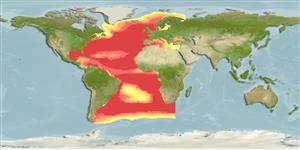Classification / Names
Common names from other countries
Main reference
Size / Weight / Age
Max length : 458 cm TL male/unsexed; (Ref. 26340); common length : 200 cm FL male/unsexed; (Ref. 168); max. published weight: 684.0 kg (Ref. 26340); max. reported age: 32 years (Ref. 5810)
Length at first maturity
Lm ?, range 97 - 110 cm
Environment
Marine; brackish; pelagic-oceanic; oceanodromous (Ref. 51243); depth range 0 - 985 m (Ref. 55291), usually 0 - 100 m
Climate / Range
Subtropical; 3°C - 30°C (Ref. 88796), preferred 26°C (Ref. 107945); 76°N - 58°S, 99°W - 42°E
Distribution
Western Atlantic: Labrador and Newfoundland to Gulf of Mexico, and Caribbean Sea to Venezuela and Brazil. Eastern Atlantic: Lofoten Islands off Norway to Canary Islands, including the Mediterranean and the southern part of the Black Sea (Ref. 6769). Reported from Mauritania (Ref. 5377). There is a subpopulation off South Africa. Highly migratory species, Annex I of the 1982 Convention on the Law of the Sea (Ref. 26139).
Countries | FAO areas | Ecosystems | Occurrences | Introductions
Short description
Dorsal
spines
(total): 12 - 14;
Dorsal
soft rays
(total): 13-15;
Anal
spines: 0;
Anal
soft rays: 13 - 16;
Vertebrae: 39. A very large species, deepest near the middle of the first dorsal fin base. The second dorsal fin higher than the first; the pectoral fins are very short, less than 80% of head length. Swim bladder present. Lower sides and belly silvery white with colorless transverse lines alternated with rows of colorless dots. The first dorsal fin is yellow or bluish; the second reddish-brown; the anal fin and finlets dusky yellow and edged with black; the median caudal keel is black in adults. May be confused with several other tunas, these are typically much smaller and easily distinguished by specific patterns of stripes, bands or dots.
IUCN Red List Status (Ref. 115185)
Threat to humans
Harmless
Human uses
Fisheries: commercial; aquaculture: commercial; gamefish: yes
Tools
Special reports
Download XML
Internet sources
Estimates of some properties based on models
Phylogenetic diversity index
PD50 = 0.5039 many relatives (e.g. carps) 0.5 - 2.0 few relatives (e.g. lungfishes)
Trophic Level
4.5 ±0.8 se; Based on diet studies.
Resilience
Low, minimum population doubling time 4.5 - 14 years (K=0.05-0.06; tm=3-5; tmax=15; Fec=10 million)
Vulnerability
Very high vulnerability (82 of 100)
Price category
